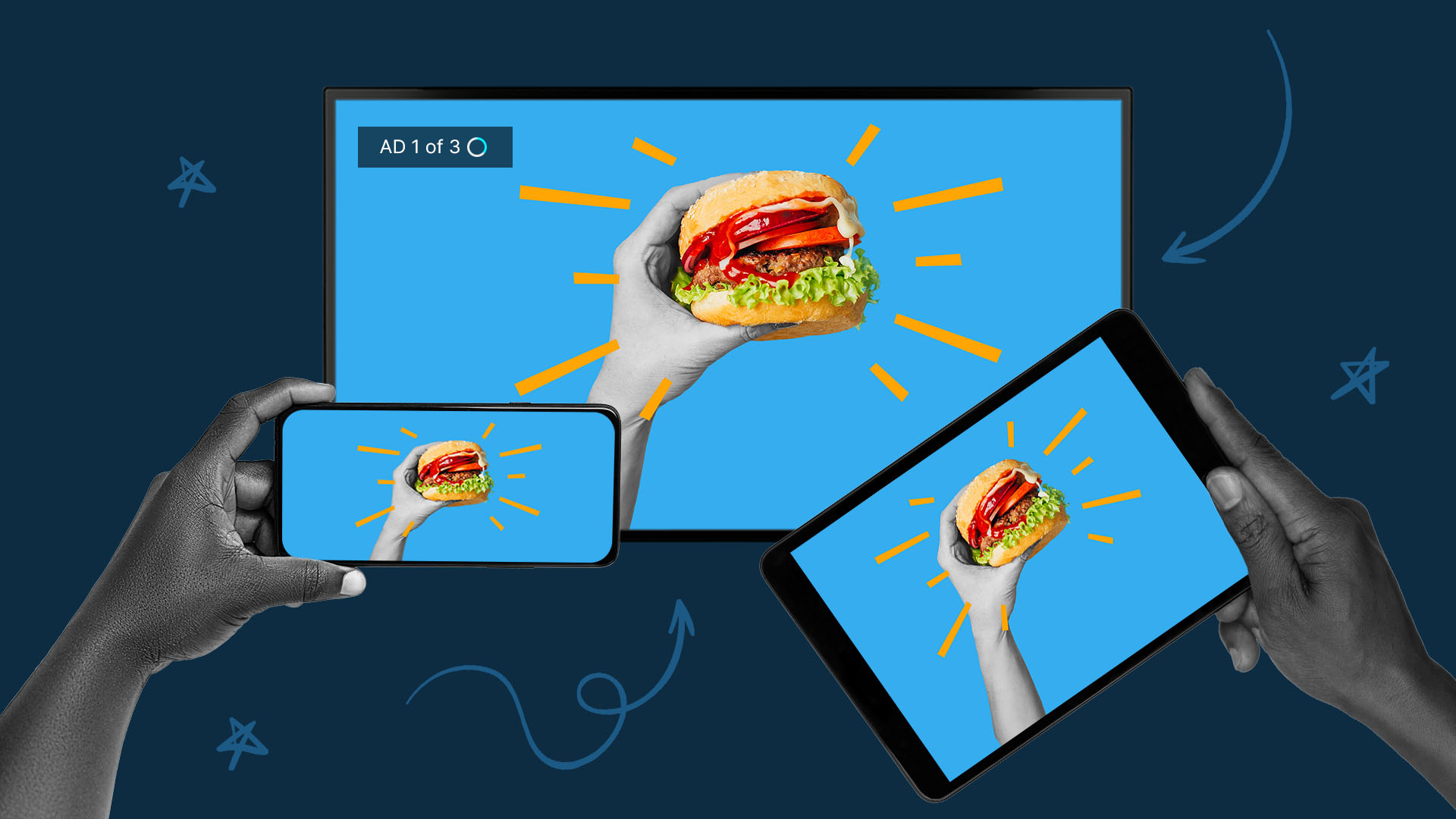Video Marketing Habits We’ve Picked Up Since March 2020

We really don’t need to tell you what happened in March of 2020.
(Hint: it rhymes with academic)
But as we enter Year Three of the COVID-19 pandemic, you still may be asking yourself: what. is. happening?
Major industries across the corporate sphere, like advertising, have always had to continuously adapt to consumer trends and behaviors–all of which were dramatically turned on their ear when COVID-19 changed the world in March 2020. As we sheltered-in-place (remember those days?!) video content consumption skyrocketed, with 83% of U.S. viewers accessing video content regularly.
While this presented an incredible opportunity to release more video ads that directly engaged with pandemic-era anxieties, the process of creating these video marketing ads had to rapidly evolve. Advertisers must now prioritize the safety of cast and crew above all else, while also meeting the moment to provide content that matches new consumer expectations of brands, from small eCommerce businesses to corporate power players.
There are several key ways the COVID-19 pandemic impacted how we make video ads. In a world on the precipice of a “new normal” (that we hope can soon become our “normal normal”) examining the ways content creation has changed will help you as a video marketer understand what your team can do to safely produce content that’ll hit your KPIs and resonate with your target audience.
Learn More: Social Media Video Ad Specs & Placements Guide
We’re Pros at Working Remotely
One of the biggest recurring phrases to come out of the pandemic era: “remote work.” Remote video services like Zoom, Google Hangout, and Microsoft Teams dominated the work scene in the early stages of the pandemic and continue to have prominence going into 2022. Many companies are opting for hybrid workplaces that allow workers to communicate via video on days they work from home.
Video conferencing tools like Zoom helped keep the world’s work afloat during unprecedented times.
Besides using tools like Zoom to conduct team meetings, marketers also used video communication software to help direct advertising shoots and make creative decisions virtually. While some saw virtual calls as an initial disadvantage, many marketers have embraced virtual communication and see it as a great way to get everyone involved on the shoot, no matter their location. This method also ensures fewer bodies are required on set, minimizing the risk of virus spread.
Another popular remote work practice in COVID advertising is the use of video drop kits. These kits consist of contactless video production equipment, including high-tech cameras, lighting, and sound devices. Rather than gathering a large crew to set up and control these vital pieces of equipment, the kits come ready-made and easy to set up to get production underway seamlessly. Video drop kits have also made the entire video production process quicker, easier, and less expensive, making it a remote trend that’s here to stay.
We’re More Thoughtful About World Issues
The key to successful advertising of the future lies in empathy. In fact, nearly 80% of today’s consumers are motivated to buy from brands that aim to make the world a better place. While the expansion of empathy in advertising had been rising pre-pandemic, the struggles caused by COVID-19 for billions across the world have only made consumers crave more of it. Consumers want to know that brands are willing to take a stand for social and environmental causes they believe in, such as via donations or brand messaging. Essentially, buyers need to see the light at the end of a very dark tunnel.
What does this mean for your video production? It means reconsidering the text and images included in video advertisements to ensure they are aligned with consumer values. It also means staying alert and avoiding any kind of messaging that could be perceived as insensitive to viewers. While this takes time and research, the rewards are well worth the effort. Empathetic brands have loyal consumers who go on to spread the good word and increase brand awareness both online and offline. In fact, empathy works as the perfect word-of-mouth marketing strategy today.
We’re Moving at the Speed of Culture
The Chief Creative Officer of MNTN, actor Ryan Reynolds, has said that to make noise in the video advertising industry, you have to move at the same rhythm as the cultural ecosystem of the internet. The internet’s “cultural ecosystem” has been fascinating to watch during the pandemic. Internet users constantly (and quickly) respond to and engage with an ever-evolving flow of changes around the world on social media sites and apps.
As a result, advertisers and marketers must master agility and the ability to adapt to changing trends at a moment’s notice. Behaviors and desires of modern-day consumers move at a lightning-fast pace, and not seizing up the right opportunity at the right moment could lead to outdated and unappreciated video advertisements. These lead to a drop in sales and brand success.
However, the pandemic has taught many of us how to move in such an accelerated manner, making the process much easier over time. The advertising industry has had its own ways of responding with agility, such as with streamlined remote work production crews. Keeping an open mind and a willingness to try new measures of acceleration will ensure you are moving at today’s speed of culture.
Data Privacy Changes Impact Ad Creative
Over 2021, the world of data privacy jumped leaps and bounds in improving individual consumer data protection. These were long-overdue changes that brought data autonomy back to users, but it had a secondary effect in limiting–and at times erasing–the efficacy of advertisements for literally everyone.
This has required brands to make agile moves to account for these disruptions by latching on to the one thing they’ll always have control over: their ad creative. Now, rather than targeting hyper-specific audience cohorts, your ads must include a broader audience. The opportunity here? By focusing your creative on larger segments, rather than your historical targets, you have the ability to turn passive audiences unaware of your product into passionate consumers who are devotees for what you offer!
We Don’t Sweat the Best Laid Plans
Since 2020, we’ve lived in a world of uncertainty where it seems we take two steps forward and one step back. For advertisers, that means a level of uncertainty when it comes to pulling the trigger on new advertising campaigns. But rather than letting the uncertainty overtake any ad launching, advertisers and marketers have learned to embrace this reality. Don’t sweat it if you have to change your ad campaign to better reflect the reality of the month, week, or even day that you plan to run the ads. Many industries worldwide are in the same place, and consumers understand this.
Nonetheless, it’s also a good idea to make use of trending advertising methods, such as using animation or repurposing existing assets. For instance, you can add new animated text or graphics to existing footage, freshening it up with a new visual style. Alternatively, you can use existing footage and upload it to new platforms, switching technicalities like length or ratio or tailoring messages to new audiences. There’s no need for pressure to continuously pump out new footage and content, especially in an age where consumers want more and more content from brands. Using what already works generates a higher likelihood of success.
We Lean Into New Trends the Zoomer Way
Let’s face it: Tik Tok is now the social media king. The video-sharing app has over 1 billion daily users sharing bite-sized videos about every topic under the sun. Many different social media apps and sites have decided to copy this short-video trend, such as Instagram with its Reels and YouTube with its YouTube Shorts. It seems that the internet is obsessed with the less-is-more video format, and advertisers are quickly catching on.
Move over, Facebook: Tik Tok is now at the center stage of social media usage, and it’s expected to stay that way.
As for the short-video rage, we can thank Generation Z, commonly referred to as Zoomers. Like with every generation before it, Zoomers have set the direction for what they want to see and how they want to see it. For instance, the 9×16 video aspect ratio has taken over past-popular choices like the 1×1 and 16×9.
To lean into this trend, advertisers are now creating video ads with their smartphones or with a smartphone stylistic format. What’s more, brands are using prevalent Tik Tok fads that Zoomers want to see, such as the incorporation of hashtags, collaboration with popular influencers, and video uploads of user-generated content. Even using a trending song in a Tik Tok clip can lead to millions of views from prospective customers.
In the end, apps like Tik Tok are helping marketers in more ways than one. Tik Tok videos don’t require lavish production equipment or a huge budget — they can be done with the use of a smartphone and simple editing on the app. Making use of these Zoomer trends is a surefire way to grow a large, young audience that is hungry to keep up with brands in today’s age.
2022: A Challenge and an Opportunity
As long as the pandemic sticks around, so will uncertainty and constant change. While COVID-19 initially caused more setbacks than progress, we’re at a point where we may expect challenges, but also see them as a form of opportunity. As long as you stay on top of trends and culture, are mindful of your message, and are willing to adapt when needed, you can continue to thrive in a new advertising world.
However, you don’t have to take on video advertising in 2022 completely on your own. Quickframe by MNTN has all of the video advertising tools, strategies, and creative collaboratives you could dream of to make a video advertising campaign that delights and influences your future buyers this year and beyond. Get in touch today to see how we can help you.
Do More with Video
Learn how we can help you produce more quality videos affordably and at scale.


